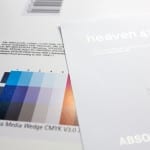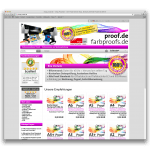Customers are often unsettled when they hold a proof in their hands. “The proof of the picture is much darker than the picture on my monitor. Why is that so? And what do I do now?”
There are many possible reasons for a deviation between the proof and, for example, the monitor display:
- The monitor is not calibrated
Only calibrated monitors can accurately display color. When I buy a cheap monitor and connect it to my computer, I definitely can’t see any real color. As a rule of thumb, only a hardware-calibrated monitor has a chance for correct color.
- The monitor is calibrated, but the colors look different
A monitor below 1,000 Euro cannot usually be calibrated to good color representation for the standard color space ISOCoated V2, because it has a too small color gamut. Only real proof monitors are also designed and suitable for the display of proofable colors.
- The proof is not viewed under D50 standard light
Especially in winter the lighting conditions are often poor. And incandescent lamps, energy-saving lamps and conventional neon tubes only provide very poor colour reproduction. Without a D50 light source, a proof cannot be evaluated.
- The color settings in the software are wrong
Often the image editing software like Photoshop is simply installed and used without adjustments. The selected color profiles often do not correspond to the profiles used for proofing. Apple-Shift-K for Macintosh and Control-Shift-K for Windows show you your profile settings in Photoshop.
In general, no patent remedy can be given for the correct display of proofs for the monitor. However, if a proof is provided with UGRA/Fogra media wedge CMYK V3.0 and test report, the chances are high that it reproduces the required colors very precisely. If your monitor image does not correspond to the proof, the error usually lies with you. The list of causes above can help you in troubleshooting.

EAN codes are standard on every product today. While in the good old days, shopowners themselves typed the prices into a cash register by hand, today scanner cash registers are the rule, which scan standardized EAN codes with a laser and thus clearly recognize the article and add it to the receipt. EAN, by the way, stands for “European Article Number” and was replaced in 2009 by the global GTIN, “Global Trade Item Number”. The EAN or GTIN is a barcode that can be read automatically and read by barcode … read more

Digimarc is a digital watermark that can be used to embed information in images, videos or other media. Digimarc watermarks are invisible to the human eye, but remain recognisable to special software or devices. Digimarc is becoming increasingly popular in the packaging sector in particular, as this technology allows the digits of the EAN barcode and more to be applied invisibly to all areas of the packaging. Digimarc and EAN barcode at the supermarket checkout When scanning at the checkout, the checkout staff do not have to search for the … read more

Requests such as the proof of a printed tin can often reach us. Why can’t such a printed can be “proofed”? A proof is a standardized product. Take the classic ISOCoatedV2 proof, for example; the standard proof for coated printing paper. Here is the definition in brief: “Paper type 1 and 2, glossy and matt coated paper, dot gain curves A (CMY) and B (K) from ISO 12647-2:2004” (Source: farbproofs.de) Metal is printed with a varnish. Neither the colour of the metal of the tin can nor the colour of … read more

Proofing service providers are often asked the question: “I have to have a proof done, but I don’t know for which profile. Can I also have a proof made without a profile?” Proofs are standardized products that are created and tested according to a certain set of values. This is exactly the point that distinguishes them from any “colourful printouts”. Specifically: A proof for coated printing paper is produced according to the standard values of ISOCoated V2 (paper type 1 and 2, glossy and matt coated image printing, dot gain … read more

The Proof GmbH provides proofs for Scheufelen Heaven 42 papers on the new EFI 8245 OBA proofing paper. With this new proofing paper it is now possible to proof the bright-white paper dye of Heaven42l. With Heaven 42 a bright white paper was developed by the German paper company Scheufelen, which opened up a new color whiteness. Especially technical motifs (shades of gray, silver tones from 4c, strong contrasts) act on Heaven 42 particularly brilliant and neutral. With an unchanged separation (eg with ICC profile “ISOcoated_v2”), but the printed image with the … read more

Offset and Newsprint ISO Coated v2 (ECI) / ISO Coated v2 300% (ECI) Profile: ISOcoated_v2_eci.icc Standard for glossy and matte coated paper Paper: Types 1 and 2, gloss and matte coated Tone value increase curves A (CMY) and B (K) as defined in ISO 12647-2:2004 Characterisation Data: FOGRA39L ISOUncoated Profile: ISOUncoated.icc Standard for uncoated white natural paper Paper: paper grade 4, uncoated white offset, dot gain curves C (CMY) and D (K) from ISO 12647-2: 2004 Characterisation Data: FOGRA29L PSOCoatedV3 / Fogra 51 Profile: PSOcoated_v3.icc The successor of ISOCoatedV2 for glossy … read more

From now on you can conveniently order proofs at shop.proof.de: At shop.proof.de is available under shop.proof.de a comfortable online shop with numerous benefits available: Convenient Data Upload: Each item one or more files can now be uploaded. So you can assign your data directly to the individual proofs. Payment by Paypal, direct debit, invoice etc .: You are on shop.proof.de with Paypal and direct debit payment methods more available. Of course you can continue to conveniently order proofs on invoice. See Previous orders, invoices, data uploads: You can always check your … read more

In this short image video we – the Proof GmbH – introduce us and our work. Find out who we are and what drives us. What do you think of our short film?

“We print 135gr/sqm on a Berberich Allegro. Can you make us a proof on this paper? Can you proof on our final production paper?” Our telephone support often asks for a proof on production paper. Unfortunately, we always have to answer the question negatively. I would like to briefly explain the reasons for this in the following article. Proofing on production paper is still technically impossible. All proofing systems currently certified by Fogra are based on an inkjet printer as a test printer, mostly from Epson, Canon or HP. These … read more

For some years now, the possibilities of colorimetric measurement of printing inks have become simpler and cheaper. And so it is often believed that measuring printing inks is simple, inexpensive and, above all, highly accurate. And this also across a wide variety of brands and generations of measuring devices. Is that true? If you look at a few studies, that does not necessarily seem to be the case. IFRA, for example, requires that when measuring BCRA ceramic tiles the colour differences between different measuring instruments should be below Delta-E 0.3. … read more





